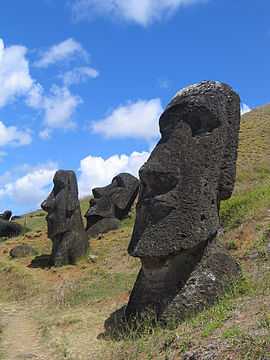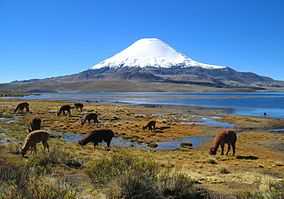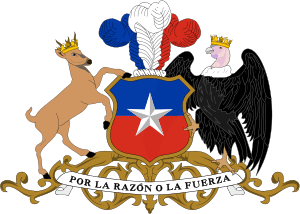Tourism in Chile


Tourism in Chile has experienced sustained growth over the last decades. Chile received about 1.25 million foreign visitors in 2006,[1] up to 2.50 million in 2007[2] The percentages of foreign tourists arrivals by land, air and sea were, respectively, 55.3%, 40.5% and 4.2% for that year.[1] The two main gateways for international tourists visiting Chile are Comodoro Arturo Merino Benítez International Airport and Paso Los Libertadores.
Chile has a great diversity of natural landscapes, from the Mars-like landscapes of the hyperarid Atacama Desert to the glacier-fed fjords of the Chilean Patagonia, passing by the winelands backdropped by the Andes of the Central Valley and the old-growth forests of the Lakes District. Easter Island and Juan Fernández Archipelago, including Robinson Crusoe Island, are also major attractions.
Many of the most visited attractions in Chile are protected areas. The extensive Chilean protected areas system includes 32 national parks, 48 natural reserves and 15 natural monuments.[1]
Since 2005 local people groups have been working on a project, Sendero de Chile,[3] to create an 8,000 km trail throughout Zona Sur for bicycling and hiking. This trail demonstrates a shift from traditional tourism to ecotourism, and when complete will travel through various provinces and regions, primarily south of Zona Central.
Norte Grande
Atacama Desert, which has been inhabited for several thousand years, makes up the main portion of Norte Grande. A myriad of geoglyphs, petroglyphs and pictographs attest the presence of ancient cultures in the area. Among the most remarkable are those of Azapa Valley, Lluta Valley, the Atacama Giant and Pintados Geoglyphs, these latter are protected within Pampa del Tamarugal National Reserve. R. P. Gustavo Le Paige Archaeological Museum and Archaeological Museum of San Miguel de Azapa are home to the most important collections of artifacts and mummies in Chile, including the famous Chinchorro mummies, the oldest mummies in the world. The extreme aridity of the Atacama has been a key factor in the preservation of such archaeological remains.
Arica is a coastal city with beautiful beaches and is also a starting point for travelers heading east to Putre for enjoying the majestic Puna landscape of Lauca National Park. Southward from Lauca, Volcán Isluga National Park includes ceremonial sites for the Aymara people.

Inland from Iquique, the desolate pampas are home to a few scattered towns and villages. Among those, the most interesting is the ghost town of Humberstone. In this area the tamarugo forests of the Pampa del Tamarugal break the barren monotony of the landscape.
The altiplano of Norte Grande has a wide variety of natural scenery including salt flats, volcanoes, lakes and geysers. San Pedro de Atacama and surrounding area offer one of most spectacular combinations of archeology and awe-inspiring natural sights. San Pedro was the cradle of the Atacameño Culture. Villages with interesting cultural past are Caspana, Toconao, Socaire and Chiu Chiu. Notable are also the pre-Hispanic fortresses of Quitor, Lasana and Turi. Two popular destinations in this area are Valley of the Moon, so-named because its landscape resembles the moon, and El Tatio Geysers. Antofagasta is the largest city in Norte Grande. La Portada, a stunning natural arch, is located a short drive from Antofagasta.
Pan de Azúcar National Park is a park where sea and desert meet.
Norte Chico
The Andes of Norte Chico are home to many of the highest volcanoes in the world, the highlight being Ojos del Salado. Apart from Ojos del Salado and the rest of the volcanoes, attractions in this portion of the Andes include Nevado Tres Cruces National Park and Laguna Verde.
Norte Chico boasts some of the best beaches and exclusive coastal resorts in the country, such as Bahía Inglesa and those of La Serena.
The clear skies of Norte Chico and its world-renowned infrastructure have made it ideal for astronomical tourism.
Elqui Valley is a very popular destination. Here, the dazzling green of the valley floor contrasts nicely with the barren brown slopes of the mountains that flank it.
Zona Central
This area is home to the main ski resorts in Chile, which attract a significant number of tourists from the northern hemisphere because the reversed alpine skiing season. They are Chapa Verde, Portillo, Valle Nevado and Termas de Chillán. Furthermore, Wine tourism is common in Zona Central, and the Wine Routes of the Casablanca, Cachapoal and Colchagua valleys are some of the finest in Chile.
Apart from the national capital itself and its many attractions, the metropolitan region surrounding Santiago includes several attractions such as the Cajón del Maipo, Pomaire, and some of the oldest vineyards in the country, as well as various archaeological sites.[4]
West of Santiago, Valparaíso is a wonderful, amphitheater-shaped city, whose historic quarter has been recognized as a World Heritage Site. Its neighboring city, Viña del Mar, attracts a large number of foreign tourists, particularly from Argentina.
The O'Higgins Region, south of Santiago, is known as "Huaso country" for its rural criollo culture.[5] Pichilemu, in the O'Higgins Region, is reputed to have the best beaches for Surfing in Chile, if not the world.[6] Other tourist sites in the O'Higgins region include the historically significant city of Rancagua, Sewell and the Rio de los Cipreses nature reserve.
Further south in the Maule and Bio Bio regions are the Radal Siete Tazas National Reserve and Laguna del Laja National Park.
Zona Sur
Araucanía Region is the heartland of the Mapuche people. This area exhibits an incipient development of Indigenous tourism, in different sectors. in the coastal area of Araucania Ethnological tourism is developed on the banks Mapuche Budi Lake.
The Andean sector of Araucania, highlight the great national parks, such as Conguillio National Park the forest of araucarias, Villarrica National Park, huerquehue National Park, Tolhuaca National Park besides the national reserves as Alto Biobio National Reserve, Malalcahuello National Reserve, Nalcas National Reserve, Malleco National Reserve, China Muerta National Reserve.
The capital of Araucania is Temuco, city of different service, hotels, tourist circuits, airport, markets, and the symbolic and historic sectors, the Cerro Ñielol Natural Monument is an icon of this city, and the most important tourist point.
The Lake District is characterized by piedmont lakes crowned by snowcapped volcanoes, whose lower flanks are covered with lush forests of native trees. Lovely towns and villages dot the lakesides, chiefly Pucón, Villarrica, Frutillar and Puerto Varas. Puerto Montt is the tourist hub of the region.
The most visited national parks include Puyehue National Park and Vicente Pérez Rosales National Park, the latter is Chile's oldest national park.
Valdivia is one of Chile's most beautiful cities, recognition received mainly because of its lush natural surrounding. South from the city lies the colonial Valdivian Fort System.
The almost perfect cone of Osorno Volcano is an iconic landmark in the region. Alike Villarrica Volcano, which is one of the few volcanoes in the world that have an active Lava lake.
As an added bonus, this zone includes the granite domes of the Cochamó Valley.
Zona Austral
Zona Austral is a premier destination for Ecotourism and Adventure travel. It features countless islands and islets, a maze of steep-sided fjords and channels, large glaciers and icefields and exuberant unspoilt temperate rainforests. Turbulent rivers descend from the Andes, chief of those being the Futaleufú River, which is widely considered one of the world's most challenging rivers for whitewater kayaking and rafting. Other opportunities for outdoor recreation, include hiking, cycling, sea kayaking and flyfishing.
Chiloé is characterized by having a rolling green countryside, but is better known for its peculiar wooden architecture and for its culture, which is full of myths and traditions. Also is remarkable its temperate rainforests.
The scenic Carretera Austral crosses or is nearby to many of the most popular destinations in this portion of Chile. Those include Pumalín Park, Yelcho Lake, Queulat National Park, Cerro Castillo National Reserve, General Carrera Lake and Caleta Tortel.
Laguna San Rafael National Park is the only park where visitors can contemplate at the same time the huge glaciers of Patagonia and the rich diversity of plants of the Valdivian Ecoregion.
Pío XI Glacier, one of the few advancing glaciers in the world, is a must-see in the Chilean Inside Passage.
Torres del Paine National Park is the main attraction in Zona Austral and one of the most beautiful national parks in the world.
The sprawling glaciers of the Cordillera Darwin, which is contained within Alberto de Agostini National Park, are reachable only by boat. Other typical destinations are Puerto Williams and Cape Horn.
Easter Island
Easter Island is world-renowned for its cultural, unique and natural heritage. It is named Easter Island because it was discovered on Easter Sunday in 1722. It also has mysterious statues which have been shrouded in mystery since their discovery.
Juan Fernández Islands
Juan Fernández Archipelago is also well known for its jungles and endemic flora. The Juan Fen´nadez islands are also known for being inhabited by Alexander Selkirk, the man who inspired the Robinson Crusoe novel. In 1966 the Chilean government renamed Isla Más Afuera to Alejandro Selkirk and Isla Más a Tierra to Robinson Crusoe, in order to promote tourism. Incidentally, Selkirk never set foot on Más Afuera, only on Más a Tierra.
Ethical Traveler Destination
Chile has been included in the 2010, 2011 and 2012 lists of "The Developing World's 10 Best Ethical Destinations." This is an annual ranking produced by Ethical Traveler magazine, which is based on a study of developing nations from around the world to identify the best tourism destinations among them. The benchmarking uses categories such as environmental protection, social welfare, and human rights.[7][8][9]
See also
References
- ↑ 1.0 1.1 1.2 "2006 Tourism Report". INE. Archived from the original on 2008-07-30. Retrieved 2008-08-05.
- ↑ http://www.tourismroi.com/Content_Attachments/27670/File_633513750035785076.pdf
- ↑ http://www.senderodechile.cl/portal/
- ↑ "Arqueologia.cl". Arqueologia.cl. Retrieved 2 November 2012.
- ↑ "About Chile & It's People". O'Higgins Tours. Retrieved 2 November 2012.
- ↑ "Pichilemu". TurismoLibertador. Retrieved 2 November 2012.
- ↑ "Ethical travel destinations unveiled: Argentina, Barbados, Chile". The Independent. Relaxnews. 2010-12-10. Retrieved 2010-12-11.
- ↑ Jane Esberg, Jeff Greenwald and Natalie Lefevre. "The Developing World's 10 Best Ethical Destinations". Ethical Traveler. Retrieved 2010-12-11.
- ↑ "The Developing World’s 10 Best Ethical Destinations: 2012". Ethical Traveler. 2012-01-05. Retrieved 2012-01-26.
External links
| Wikimedia Commons has media related to Tourism in Chile. |
| Wikivoyage has a travel guide for Chile. |
- National Tourism Service
- Virtual Tour in 360° of Chile
- Travel: Chile by Rich Grant, International Business Times, May 11, 2009
- Traveling in Chile - this is Chile - Official Chile website
- El colorado official site
- Ski guide of Chile.
- Federation of Ski and Snowboard of Chile
- Chile Travel Blog Directory
| ||||||||||
| |||||||||||||||||||||||||||||||||||||||||||||||||||






.jpg)
